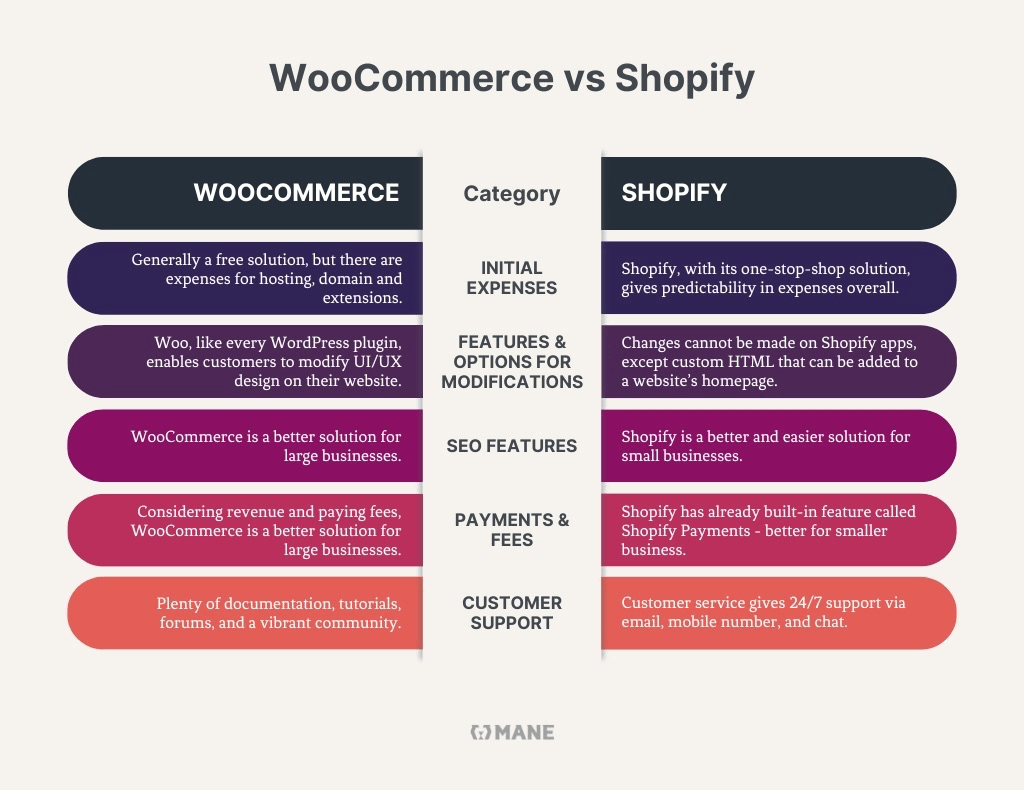
WooCommerce vs Shopify – a Head-to-Head Comparison
Whatever the reason for creating an eCommerce storefront, for your own needs or a client, you are in the right place. If you have a dilemma, WooCommerce vs. Shopify, we will give you some pros and cons for both platforms. They are the most popular and developed tools for establishing a successful e-commerce site.
Before we start the analysis, we will show you some data gathered from the e-commerce market. In recent times, Shopify has had rapid growth, with its stock gaining over 134% this year. The company has published on its website that there are 800,000 active stores hosted on its platform.
However, on the WooCommerce website, there is a counter that shows the number of plugin downloads (WooCommerce is a plugin for WordPress). When we checked how many times the plugin has been downloaded, it says 82,952,371 downloads! It has been used in over 28% of all online stores. Considering that the percentage of Shopify stores is around 20%, we can say that Woo is more prevalent among small to mid-sized companies but not necessarily better than Shopify.
Let’s look at both platforms and their characteristics so you can get the right impression and make an informed decision. For any aspect we analyze in this article, we will give facts related to small and medium eCommerce stores and larger ones.
- Initial expenses
- WooCommerce and Shopify features and options for modifications
- Woo vs. Shopify for SEO
- Payments (implementation and amount) and fees
- Customer Support
1. Initial expenses
In our agency, Mane Digital, clients often ask us: Is WooCommerce free? How much does Shopify cost?
There is a rumor that you have to pay for the Shopify plan and that Woo is a free solution. Although it seems like that at first sight, things are slightly different.
Speaking of how much WooCommerce costs, we can’t say there are no costs involved. There are expenses you may have if you decide to use this WordPress plugin:
- Themes- In general, WordPress has free WooCommerce themes, and there are those you have to pay for (approximately $59). Although free ones are more appealing, support hasn’t been provided in case of any issues.
- Plugins – Similarly, if you choose a free plugin, and it begins to bug, you will have to solve it on your own (or by your dev, which costs too). On the contrary, in the case of a paid plugin, you can contact their support to help you.
- Hosting – It is not difficult to buy hosting. There are plenty of hosting providers on the market. However, this service costs approximately $12 per year.
- A domain name – Of course, you have to buy a domain, its price depends on the type (.com, .net., .us, etc.), but it is similar to your hosting price unless you buy them together.
- Extensions – These are a type of plugin for eCommerce businesses (add-ons for shipping, credit card payments, accounting, etc.). Like plugins, if you decide to pay for them, their prices are between $29 and $79 per year.
- SSL certificate – In case it is not included in your hosting, having this kind of security is important. So you will have to plan for this expense as well.
- The developer – Last but certainly not least, you have development costs. You will have to employ a developer or outsource a professional agency if you don’t have the technical skills to implement the WP website and all other necessary elements. The range of prices can vary.
On the contrary, Shopify fees cover the above-mentioned expenses.
- Small businesses: Although you have more choices if you use the WooCommerce platform for your e-commerce storefront, if you are not skilled and experienced enough, Shopify, with its one-stop-shop solution, gives you predictability in expenses overall.
In the WooCommerce vs. Shopify cost “battle” for SMEs: We vote for Shopify.
- Large businesses: If you already have a viable business model that works and makes you a stable revenue, WooCommerce is a rather good solution. With professional developers in your team or outsourced, your expenses would probably be less with Woo than with Shopify.
In the Woo vs. Shopify cost “battle” for large businesses: We vote for WooCommerce.

2. WooCommerce and Shopify features and options for modifications
The similarity between those two platforms is that both use themes offered to customers as a basic design step.
WooCommerce, as a part of the WordPress platform, enables customers to change their sites with plugins. Although many independent websites sell plugins for eCommerce shops, we can consider that the WordPress.org directory has over 6,000 plugins with ‘WooCommerce’ in the title. It means that at least so many plugins allow those who use this platform to improve its performance (UI design, customer experience, etc.).
Also, Woo, like every WordPress plugin, also enables customers who know how to code to modify UI/UX design on their website.
In terms of Shopify, besides themes, it has apps similar to plugins on the WordPress platform. You can choose them on the Shopify website. However, changes cannot be made to them, except custom HTML that can be added to a website’s homepage.
- Small businesses: Although Shopify is a great solution for start-up e-tailors and those who don’t have the technical skills for developing and modifying any part of the site, Woo is an excellent solution for those business owners who value the flexibility to change every single detail of their eCommerce.
In the Shopify vs. WooCommerce feature “battle” for SMEs: WooCommerce wins.
- Large businesses: Considering that in companies with more than 50 or 100 employees, there are at least a few developers or even a department who can quickly implement any feature management you may ask for, the WooCommerce platform can be a better choice.
In the WooCommerce vs. Shopify feature “battle” for large companies: WooCommerce wins.
3. Woo vs. Shopify for SEO
In eCommerce, it seems that SEO is more important than in any other online industry. Without good optimization for browsers and search engines, your online shop will not survive for a long time. Especially considering that “big players” are dominant in this sphere and that SMEs or even large businesses have to be optimized to compete on “the first page of Google.” Therefore, it is not surprising that both platforms, Woo and Shopify, pay great attention to helping sites be as optimized as possible.
Shopify also offers its customers an SEO-ready site structure. The platform automatically creates a sitemap. Meta descriptions, title tags, and URLs are included so every client can customize it. The same goes for file names and alt text for images.
On the other side, WooCommerce, as a WordPress plugin, cannot be observed outside of this CMS platform. Considering that there are many WordPress SEO plugins in the first row, Yoast, we can say that they give an excellent opportunity to optimize online stores built using Woo.
- Small businesses: For those online shop owners who don’t have much time and resources themselves or to outsource a professional agency, Shopify can be a more straightforward solution. At the same time, a pretty effective one.
In the WooCommerce vs. Shopify SEO features “battle” for SMEs: Shopify wins.
- Large businesses: For those eCommerce sites with a significant number of products and at least one developer and marketing person in the team, WordPress and WooCommerce are better solutions as they offer more features and more options for customization.
In the WooCommerce vs. Shopify SEO features “battle” for large businesses: WooCommerce wins.
4. Payments (implementation and amount) and fees
At the beginning of this chapter, you can guess what we will say: Shopify already has a built-in feature (called Shopify Payments), while in WooCommerce, to provide your customers with the payment method, you have to implement additional extensions. However, there are more facts everyone who decides on these platforms should know.
Payment fees
First, let’s discuss the payment fees the platforms charge their customers.
Shopify Payments is a payment method similar to others like PayPal, Square, Stripe, etc… If a store owner decides to use it, they will not be charged additional fees. However, if they don’t implement this feature, Shopify will charge a .5-2% per transaction fee on every sale, depending on their plan. In Shopify Payments, mobile card readers and in-store POS sales can be applied.
However, Shopify Payments isn’t a completely free solution. Credit Card Processing Fees vary from 2.4% to 30¢ depending on the plan and whether it is online or offline sales.
In terms of WooCommerce, it doesn’t include any payments based on site revenue. On the other side, it doesn’t have its own payment method, but it supports many payment processing options. The only cost a customer can have is related to credit card processing fees taken by their providers.
PCI-DSS
One more important thing, Shopify includes PCI-DSS (Payment Card Industry Data Security Standard), so if you choose this platform, you will not have to worry if credit and debit card payments are in line with legal regulations.
On the contrary, WooCommerce is not automatically compliant with PCI-DSS. First, you have to be secure that you have an SSL certificate, and then you can implement all required steps by the following documentation from the WooCommerce site.
- Small businesses: According to our experience and one of our clients, we can say that although WooCommerce doesn’t charge almost anything, Shopify is a better solution. Not only can the implementation of additional extensions and plugins be complex for someone who is not technically educated, but issues that might come up during purchases can slow the process of earning money and spoil the user experience.
In the Woo vs. Shopify SEO features “battle” for SMEs: We vote for Shopify.
- Large businesses: Considering the revenue that large businesses can have and the amount of money that can be saved by not paying fees, we consider WooCommerce a better solution.
In the WooCommerce vs. Shopify payment “battle” for large businesses: WooCommerce wins.
5. Customer Support
Well, it is a little bit difficult to compare those two platforms in the sphere of customer support. As a paid tool, Shopify customer service gives 24/7 support via email, mobile number, and chat. Their service is great, which is essential for every user, especially those who are not technically skillful.
However, for those who know to code or at least have experience in WordPress, WooCommerce gives plenty of documentation, tutorials, forums, and a vibrant community.
- Small businesses: No doubt, for every start-up or customer who starts their business or has a small shop, good advisors are priceless. Taking that into consideration, Shopify is a winner.
In the WooCommerce vs. Shopify payment “battle” for SMEs: Shopify wins.
- Large businesses: A company with at least one developer or even the whole team will manage WooCommerce issues without a problem. However, we cannot deny the advantage of live communication over online explanations. So we will again vote for Shopify.
In the Shopify vs. WooCommerce payment “battle” for large businesses: Shopify wins.
That’s it! Can you now decide which platform you will base your commerce storefront on? Suppose you prefer to transfer this part of the job to professionals. In that case, our team at Mane Digital has plenty of experience working with clients with high standards in web development and UI/UX design and results-driven e-commerce.



